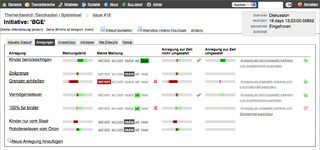Software documentation is written text or illustration that accompanies computer software or is embedded in the source code. The documentation either explains how the software operates or how to use it, and may mean different things to people in different roles.
An online community, also called an internet community or web community, is a community whose members interact with each other primarily via the Internet. Members of the community usually share common interests. For many, online communities may feel like home, consisting of a "family of invisible friends". Additionally, these "friends" can be connected through gaming communities and gaming companies. Those who wish to be a part of an online community usually have to become a member via a specific site and thereby gain access to specific content or links.
Social software, also known as social apps or social platform includes communications and interactive tools that are often based on the Internet. Communication tools typically handle capturing, storing and presenting communication, usually written but increasingly including audio and video as well. Interactive tools handle mediated interactions between a pair or group of users. They focus on establishing and maintaining a connection among users, facilitating the mechanics of conversation and talk. Social software generally refers to software that makes collaborative behaviour, the organisation and moulding of communities, self-expression, social interaction and feedback possible for individuals. Another element of the existing definition of social software is that it allows for the structured mediation of opinion between people, in a centralized or self-regulating manner. The most improved area for social software is that Web 2.0 applications can all promote co-operation between people and the creation of online communities more than ever before. The opportunities offered by social software are instant connections and opportunities to learn. An additional defining feature of social software is that apart from interaction and collaboration, it aggregates the collective behaviour of its users, allowing not only crowds to learn from an individual but individuals to learn from the crowds as well. Hence, the interactions enabled by social software can be one-to-one, one-to-many, or many-to-many.

Usability can be described as the capacity of a system to provide a condition for its users to perform the tasks safely, effectively, and efficiently while enjoying the experience. In software engineering, usability is the degree to which a software can be used by specified consumers to achieve quantified objectives with effectiveness, efficiency, and satisfaction in a quantified context of use.

An Internet forum, or message board, is an online discussion site where people can hold conversations in the form of posted messages. They differ from chat rooms in that messages are often longer than one line of text, and are at least temporarily archived. Also, depending on the access level of a user or the forum set-up, a posted message might need to be approved by a moderator before it becomes publicly visible.
Program evaluation is a systematic method for collecting, analyzing, and using information to answer questions about projects, policies and programs, particularly about their effectiveness and efficiency.
Alternative media are media sources that differ from established or dominant types of media in terms of their content, production, or distribution. Sometimes the term independent media is used as a synonym, indicating independence from large media corporations, but generally independent media is used to describe a different meaning around freedom of the press and independence from government control. Alternative media does not refer to a specific format and may be inclusive of print, audio, film/video, online/digital and street art, among others. Some examples include the counter-culture zines of the 1960s, ethnic and indigenous media such as the First People's television network in Canada, and more recently online open publishing journalism sites such as Indymedia.
Participatory design is an approach to design attempting to actively involve all stakeholders in the design process to help ensure the result meets their needs and is usable. Participatory design is an approach which is focused on processes and procedures of design and is not a design style. The term is used in a variety of fields e.g. software design, urban design, architecture, landscape architecture, product design, sustainability, graphic design, industrial design, planning, and health services development as a way of creating environments that are more responsive and appropriate to their inhabitants' and users' cultural, emotional, spiritual and practical needs. It is also one approach to placemaking.

A ropes course is a challenging outdoor personal development and team building activity which usually consists of high elements, low elements, or some combination of the two. Low elements take place on the ground or above the ground. High elements are usually constructed in trees or made of utility poles and require a belay for safety.

The Carnegie Foundation for the Advancement of Teaching (CFAT) is a U.S.-based education policy and research center. It was founded by Andrew Carnegie in 1905 and chartered in 1906 by an act of the United States Congress. Among its most notable accomplishments are the development of the Teachers Insurance and Annuity Association (TIAA), the Flexner Report on medical education, the Carnegie Unit, the Educational Testing Service, and the Carnegie Classification of Institutions of Higher Education.
Business analysis is a professional discipline focused on identifying business needs and determining solutions to business problems. Solutions may include a software-systems development component, process improvements, or organizational changes, and may involve extensive analysis, strategic planning and policy development. A person dedicated to carrying out these tasks within an organization is called a business analyst or BA.

Crowdsourcing involves a large group of dispersed participants contributing or producing goods or services—including ideas, votes, micro-tasks, and finances—for payment or as volunteers. Contemporary crowdsourcing often involves digital platforms to attract and divide work between participants to achieve a cumulative result. Crowdsourcing is not limited to online activity, however, and there are various historical examples of crowdsourcing. The word crowdsourcing is a portmanteau of "crowd" and "outsourcing". In contrast to outsourcing, crowdsourcing usually involves less specific and more public groups of participants.
The following outline is provided as an overview of topics relating to community.
A community of practice (CoP) is a group of people who "share a concern or a passion for something they do and learn how to do it better as they interact regularly". The concept was first proposed by cognitive anthropologist Jean Lave and educational theorist Etienne Wenger in their 1991 book Situated Learning. Wenger then significantly expanded on the concept in his 1998 book Communities of Practice.
Participatory culture, an opposing concept to consumer culture, is a culture in which private individuals do not act as consumers only, but also as contributors or producers (prosumers). The term is most often applied to the production or creation of some type of published media.
Social information processing is "an activity through which collective human actions organize knowledge." It is the creation and processing of information by a group of people. As an academic field Social Information Processing studies the information processing power of networked social systems.
Online participation is used to describe the interaction between users and online communities on the web. Online communities often involve members to provide content to the website or contribute in some way. Examples of such include wikis, blogs, online multiplayer games, and other types of social platforms. Online participation is currently a heavily researched field. It provides insight into fields such as web design, online marketing, crowdsourcing, and many areas of psychology. Some subcategories that fall under online participation are: commitment to online communities, coordination and interaction, and member recruitment.

Theory of Change (ToC) is a methodology or a criterion for planning, participation, adaptive management, and evaluation that is used in companies, philanthropy, not-for-profit, international development, research, and government sectors to promote social change. A Theory of Change of a social program defines its long-term goals and then maps backward to identify necessary preconditions.

LiquidFeedback is free software for political opinion formation and decision making, combining aspects of representative and direct democracy. Its most important feature is the implementation of a delegated voting system which is to establish a new form of political representation and participation that takes into account the knowledge disparity of its participants.
User research focuses on understanding user behaviors, needs and motivations through interviews, surveys, usability evaluations and other forms of feedback methodologies. It is used to understand how people interact with products and evaluate whether design solutions meet their needs. This field of research aims at improving the user experience (UX) of products, services, or processes by incorporating experimental and observational research methods to guide the design, development, and refinement of a product. User research is used to improve a multitude of products like websites, mobile phones, medical devices, banking, government services and many more. It is an iterative process that can be used at anytime during product development and is a core part of user-centered design.